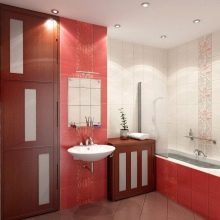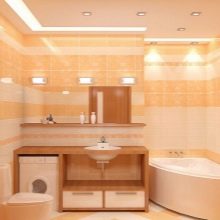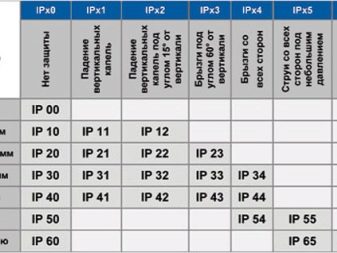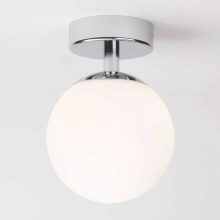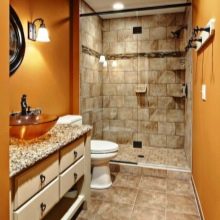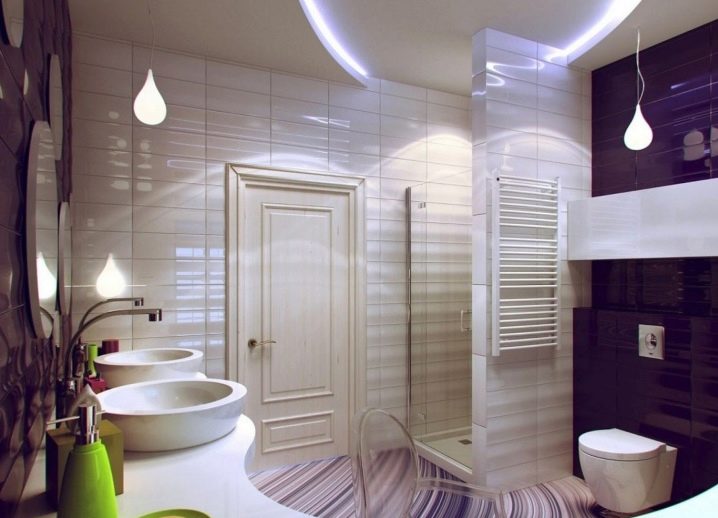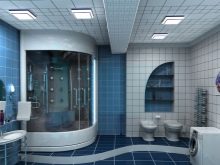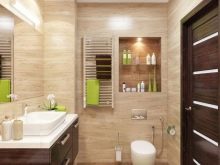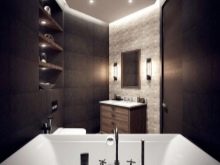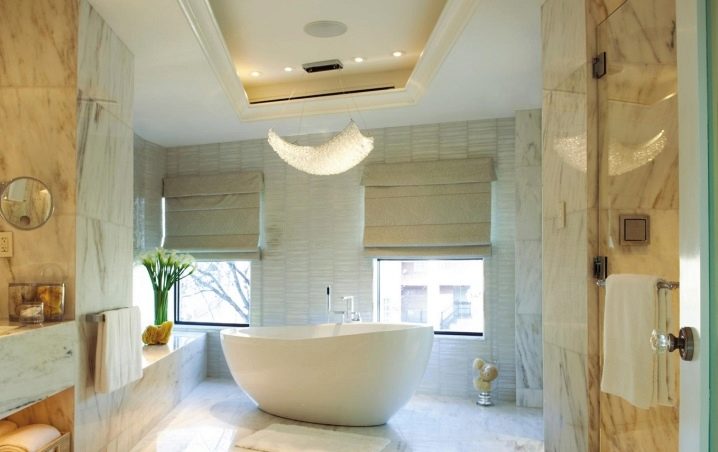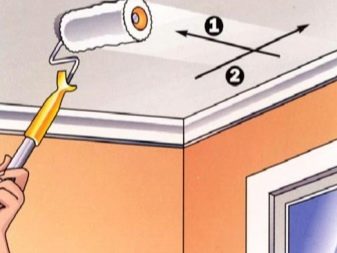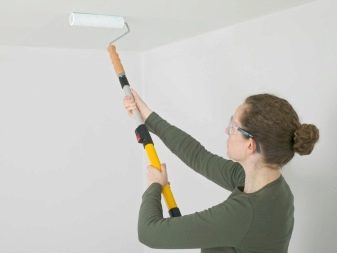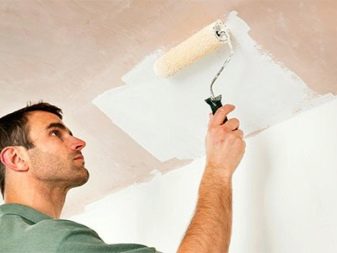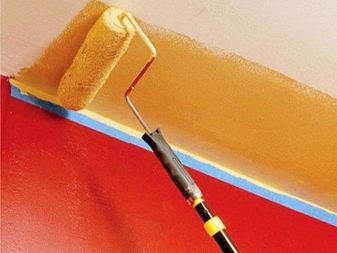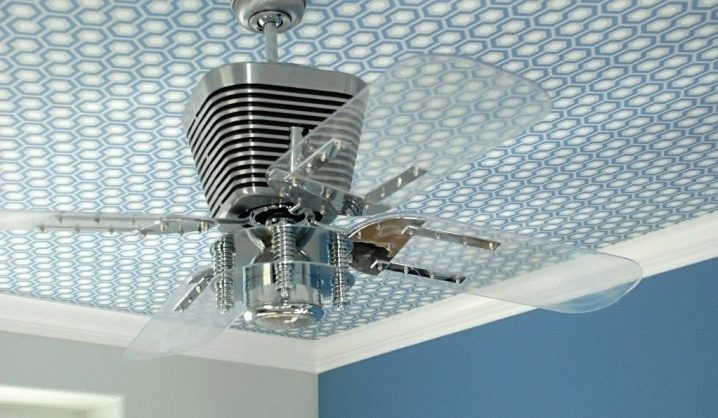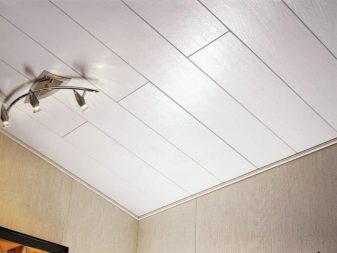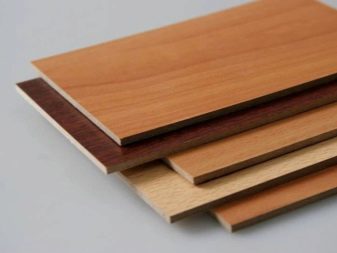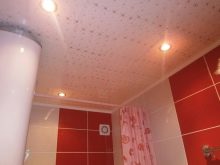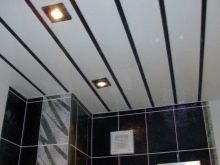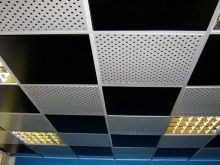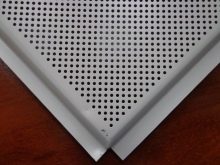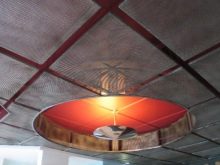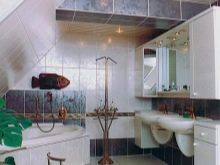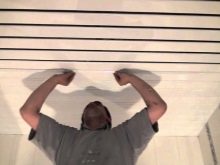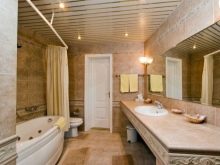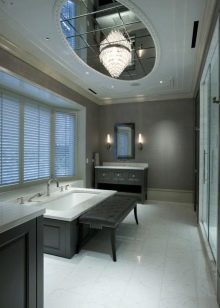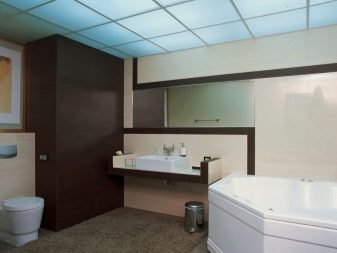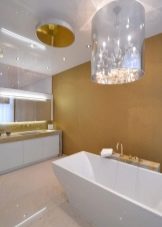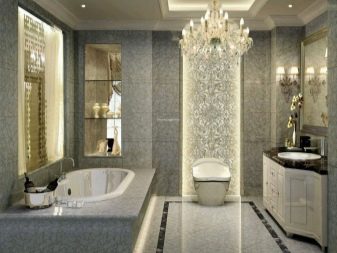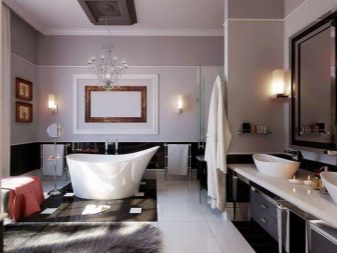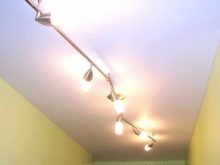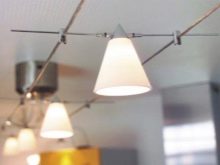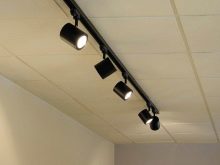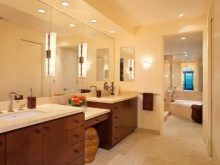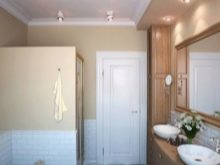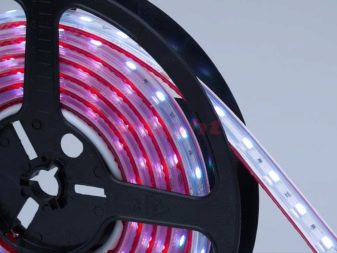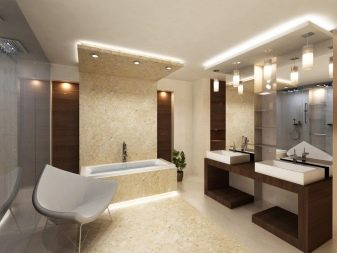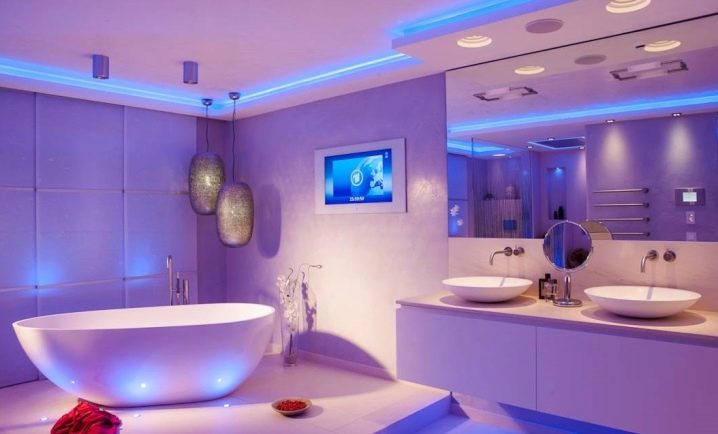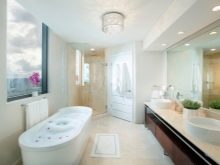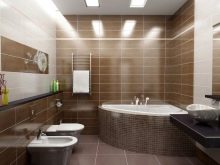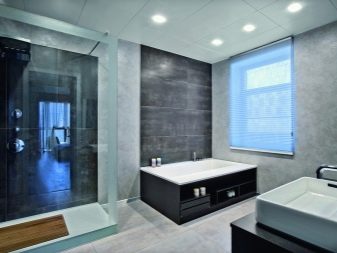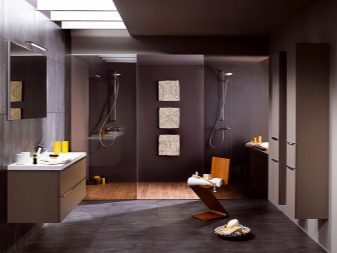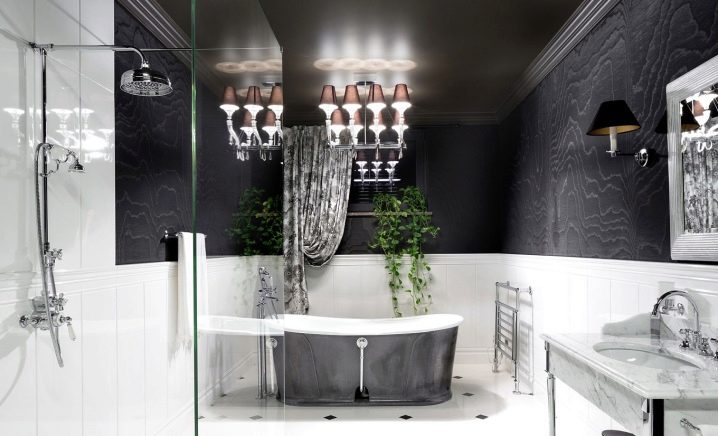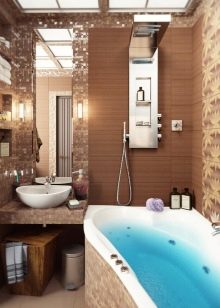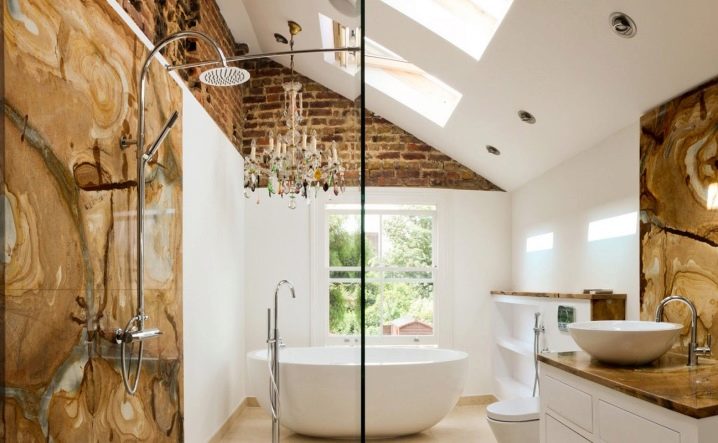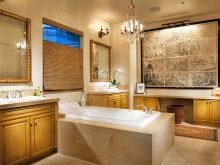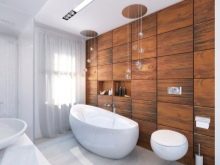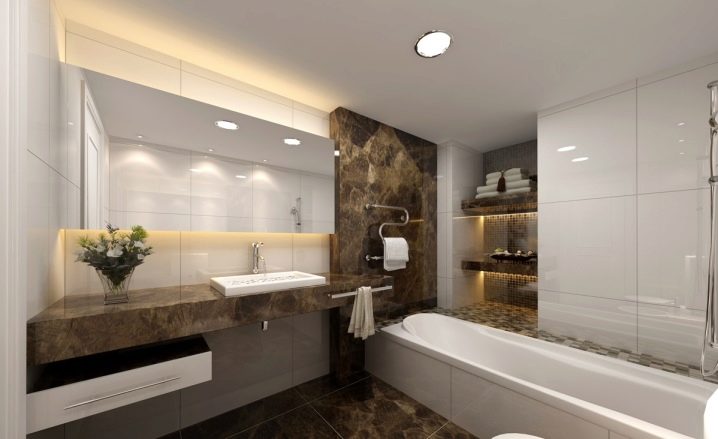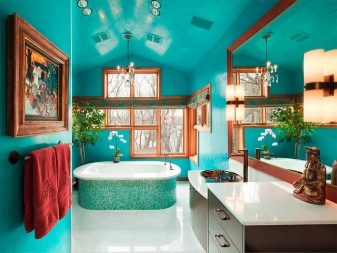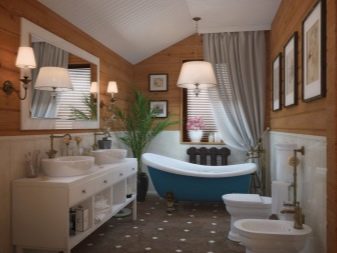Fixtures on the ceiling in the bathroom
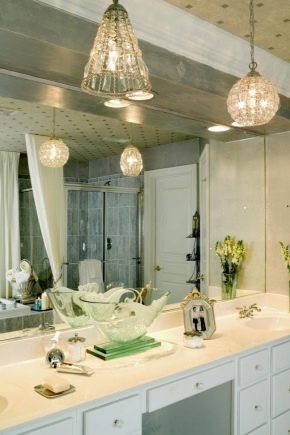
Equipping his house, a person seeks to foresee everything: to achieve comfort and beauty, the functionality of the premises, the practicality of furniture, and the safety of living. For all these points, the bathroom will make you think. It is worth understanding how to make the bathroom comfortable but safe; how to use the shower, not being afraid to splash the ceiling lamps; what kind of fixtures is better to choose on the ceiling.
Special features
Most often the bathrooms do not have natural light. It is necessary to make every effort so that the artificial light is pleasing to the eye, convenient for full use, so that it is pleasant to look at the lamps.Lying in the hot water, I want to relax and rest, and not to look at the shabby ceiling and think when I close the wiring.
- It means that creating safe conditions for the use of lighting in a wet bathroom - the first and main task when carrying out repair work. High-quality electric lamps are necessarily marked with an IP index consisting of two numbers.
The first digit determines the degree of protection from dust, the second one - from moisture. The second digit is most important. Pay attention to the voltage marking: for the bathroom it is better to select lamps with low voltage.
- Second task - Choose the right appliances. Pay attention not only to beauty, but also to specifications. For rooms with a high level of humidity, use lamps:
- the degree of protection of which is at least IP44;
- class of protection against electric shock - 2;
- with low-voltage devices (up to 12 V);
- with anti-corrosion coating of metal elements.
- Third - select the type of lighting: ceiling or wall, general or local, business or decorative.If the bathroom is large, you may be using all types.
- Fourth - Choose the right luminaire in accordance with the style.
- Fifth - Install the lamps correctly. If the light does not illuminate the mirror, you will not be able to carefully perform cosmetic and hygienic procedures. When lighting weak power in the bathroom will be uncomfortable. When using lamps with a blue spectrum, you will see a reflection in the mirror, which you will hardly like.
It is worth more familiar with the range of ceiling lights. Ceiling lighting in the bathroom can be a single lamp (central lighting), several lamps (spotlights) or a contour (around the perimeter, using small light bulbs).
Types of ceilings
To translate your ideas for repair into reality, think about how you want to see the ceiling. So that it was beautiful, safe, it was not necessary to redo it in a year due to the formed mold, corrosion, melting and deformation of the material, smudges, stains, constantly forming condensate, unpleasant smell.In addition, the installation of a stretched or suspended ceiling is usually done by at least two people. Think about whether they have enough space to work.
Do not forget about the hood - it is required in the bathroom.
When calculating the estimated costs, think about whether you need a big repair or you can get by with the “no frills” ceiling. Modern renovation does not have to be expensive. You can do the usual whitewash, staining. You can paste over the surface with vinyl wallpaper or cover with plastic panels.
Each of the methods has its pros and cons.
Whitewash
Pros: cheap and fast processing.
Cons: fragility and simplicity.
Coloring
Pros: economical option, a wide range of colors, antifungal protection.
Cons: the ceiling should be perfectly smooth, suitable only acrylic water-based paint for the bathroom, simplicity.
Vinyl wallpapers
Pros: an inexpensive option, wallpaper is not afraid of water, as they are covered with synthetic film. You can repaint the wallpaper several times in the facelift.
Cons: the ceiling should be smooth, free of defects. There should be no gaps between the strips of wallpaper so that the mold does not penetrate.
Chipboard panels
Pros: durability (with proper care), aesthetics and comfort, a pleasant smell of wood.
Cons: suitable only for rooms with good exhaust, be sure to cover waterproof lacquer, inconvenient to mount in a small room.
PVC panels
Pros: inexpensive, suitable for long-term use, color variety, easy care, moisture-resistant, easy to fit to any design, easy to install.
Cons: with a weak extract will be wet.
Suspended mineral tile ceiling
Pros: high moisture resistance (carefully choose plates with this property), after a leakage, they will not lose aesthetic appearance.
Cons: the lack of color diversity, the complexity of the installation, a rather expensive option.
Metal Ceilings
Pros: high moisture resistance, reliability, durability.
Cons: lack of color diversity, condensation accumulates and quickly sticks dust, requires frequent washing.
Suspended plasterboard ceilings
Advantages: availability of special moisture-proof sheets on sale, environmental friendliness, simple installation,the ability to create beautiful multi-level ceilings of wet drywall, easy maintenance.
Cons: not an expensive option, requires certain skills in the work.
Rack ceilings
Pros: aluminum or steel slats do not rust, do not absorb moisture, durable, do not burn, light, there is a large color variety. They are smooth, wavy or perforated, of which you can make ceilings of various configurations. Such products are easy to wash, mount.
Cons: collect condensate with improper exhaust.
Mirror ceiling
Pros: beauty, visual increase in space, a wide variety of models (color fringing and patterns on the glass), improved lighting due to reflection, simple care.
Disadvantages: material fragility, an expensive option.
Glass ceiling
Pros: not afraid of moisture, resistant to high temperatures, environmentally friendly (does not contribute to the formation of mold), is not toxic. If necessary, you can easily replace individual plates. Stained glass is very beautiful, providing volume and uniqueness.
Cons: the fragility of the material, glass with stained glass is harder to replace, high cost.
Stretch ceiling
Pros: aesthetics, modernity, the visual increase in space due to the reflective effect. Protection against leakage (the ceiling can withstand up to 100 liters of water per square meter, which can be drained by the master installer), antifungal effect, does not collect condensate, can withstand temperatures up to 50 degrees, does not deform. It is easy to take care of it, such a ceiling can be glossy or matte, in various color shades, as well as with photo printing. Cons: expensive, requires professional installation.
Whether you want to choose a bath with a whitewashed or stretch ceiling - you will face the question regarding the installation of lamps.
Models
The lamps use lamps with different principles of operation:
Lamp type | pros | Minuses |
Incandescent lamps | Cheap, easy to use | Overheating (can burn the cover), fragility |
Halogen | More durable, well lit, small in size, inexpensive | Overheating, basement individuality, ultraviolet radiation |
Fluorescent | Long service life, low power consumption | High cost, failure due to voltage drops, unpleasant color spectrum (dead light) |
LED light | Excellent light, low power consumption, long service life, do not heat up | Expensive to install, you need an additional transformer |
All four types of lamps can be used both in open (chandeliers, spotlights) and in closed (spotlights, ceiling lamps, ribbons) lamps.
In a large and high bathroom, you can emphasize on the ceiling chandelier. And it can be a single-or multi-track lamp. At the same time you can provide contour lighting - LED strip, which will appeal to romantics. It will create a special mood due to the calm yellow or white light, will give a charge of vigor with its many colors.
If the area of your bathroom is about 3 square meters. m, just install one ceiling mounted or hanging lamp. This lamp is attached to the ceiling with dowels and screws. The luminaire consists of a metal reflector disk, a cartridge, the lamp itself and a diffuser, which makes the light more uniform and protects the lamp from water. The ceiling light is good because its different models can be mounted both on the ceiling surface itself and on the suspended structure.
The negative point is the replacement of the lamp, for which it is necessary to dismantle the lens.
A good option - spotshaving several lamps on one rod and turning mechanism for each of them. They can be deployed in such a way that the light will fall on both the mirror and the bath. In this case, manufacturers offer a large selection of materials for the rods, which are mounted lighting. Bars can be nickel-plated and chrome-plated, copper and copper-bronze. Light reflected from metal will be additional lighting in the bathroom.
Conquering increasingly popular spot lighting suitable for any option. Such lamps are mounted in a suspended or suspended ceiling. They can be placed randomly or in the form of any figures. They can be of different sizes, and this will make your ceiling more attractive. There may be different colors, if it is required to solve a particular design idea.
Such products can also be not only static, but also with a turning mechanism. Part of the lamps can be sent to the sink, the other part - on the dressing table, the third - on the jacuzzi.
LED Strip Light - this is a copper strip, to which small LED bulbs are attached at a certain distance from each other. If in other rooms both open and closed tapes can be used, in the bathroom only sealed, in a silicone tube.
With the help of such lamps usually decorate the room. On the ceiling they are arranged in the form of straight or smoothly curved lines. The easiest installation option is to use a ready-made kit, which includes a self-adhesive diode tape, a power supply unit and a controller.
Tips for choosing
The choice of lighting in the bathroom is directly dependent on its size.
In ordinary apartments, the bathroom area simply calls for use in the design. minimalism or constructivism: a minimum of things and colors, simplicity and brevity, rationalism. In this case, use the ceiling without a leg on the base ceiling or a chandelier on a short leg. On the false ceiling, use spot lighting.
However, such a bath can also be “revived” - by installing multi-colored LED strips located on a multi-level gypsum ceiling.
Bathroom avant-garde style allow you to use these tricks.
Larger bathrooms will be interesting to look at. hi-tech style. Glossy stretch ceiling, nickel-plated or chrome lamps, matte dark walls, the latest types of plumbing - beautiful and fashionable.
Bathroom Art Deco - It is an atmosphere of luxury and aristoratism: luxury ceramic tiles, massive sinks, hanging chandeliers and wall lamps on the walls, an abundance of mirrors.
It does not matter if you do not know what style your ideas belong to. Try to find a suitable color combination, pick up lamps - and your shower room will turn from ordinary into such that only elite institutions can afford.
How to place?
Having defined the ceiling and lamps, you should think about how to arrange them: around the perimeter, in a circle, arcuate, chaotic, oval, multi-tier, crosswise. And this choice depends on the number of lamps, the emitted light spectrum and the size of the room.
In a small room, one lamp is enough, which is placed between the door and the mirror. For large rooms you need to determine the required number of lamps.
Lamp power standards per 1 sq. M. m:
- LED - 2.7 W;
- energy saving - 4-6 W;
- halogen - 10-20 W;
- incandescent bulbs - 25 watts.
The lighter the design, the less power is needed for lighting.
Due to the high level of humidity there are some limitations in installing luminaires in the bathroom. You can place lights vertically at 2.25 m from the floor, no closer. With a standard ceiling of 2.5-2.7 m, 0.25-0.45 cm from the ceiling remains. Suspended and stretched ceilings, chandeliers, ceiling lamps, spots should be placed above the bath and shower no lower.
Different types of luminaires will require different arrangements: a suspended or wall-mounted ceiling with moisture-proof housing is attached to the base ceiling; suspended lath and stretch ceilings are made out of recessed spotlights. On the panel of PVC or chipboard is mounted LED strip in a silicone case (around the perimeter or a given smooth line).
The distance from the wall to the spot lamp, as a rule, should be at least 20 cm, and from the PVC of the seam of the stretch ceiling to the recessed luminaire - not less than 15 cm. The chandelier hangs strictly in the center of the ceiling.
It is important to know that one spot will illuminate approximately 2 square meters. m., and a point lamp - about 1.5 square meters. mThe more lamps, the less power of each of them. But at the same time they should evenly illuminate all areas of the bathroom. To avoid glare, place the lamps perpendicular to surfaces with a mirror effect or at an angle.
Make lines for different groups of luminaires with different switches. So you will achieve a brighter light above the mirror or more relaxed when taking a bath.
Lamps can vary in cost, as well as ceilings, the main thing - ensure safety. Only then the created beauty will be valuable.
On how to choose the right lamps for the bathroom, their waterproof properties and methods of attachment, you can learn from the following video.
